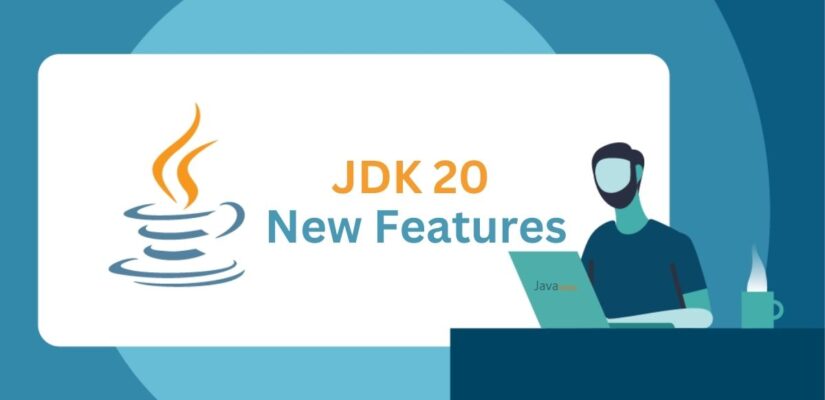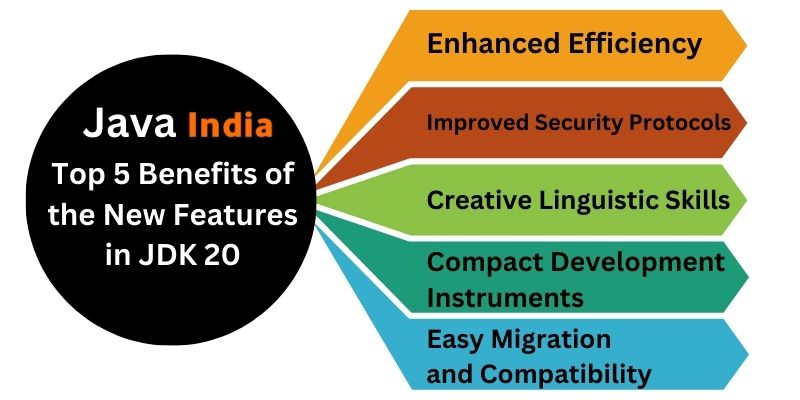
Top JDK 20 New Features: Every Java Developer Must Know In 2023
Java has a significant global presence. And Java tools are a boon to developers because of their ease of use and comprehensive features. The JDK 20 New Features are yet to release in the new year. And these features include scoped values, pattern matching, a foreign function, memory API, virtual threads, etc. Furthermore, we noticed some minor changes from JDK 19. Let’s take a closer look at the features.
An overview of JDK 20 new features
Java 20 will be available in a few months. As of JDK 20 new features are available to developers. We will provide you with an overview of these features. However, we can predict which JEPs will be in Java 20 based on JEP draughts and JEP candidates. JDK Source Structure is a JEP that describes the JDK source code and repository. It assists developers in adapting to the source code structure described in JEP 201, Modular Source Code, which is in JDK 9.

Extensive JDK 20 new features
Here are some features of Java 20 you would notice in the coming months.
Scoped values
When talking about JDK 20 new features, we jump to scoped values. It is a beta API for developing and sharing immutable data across threads. These are thread-specific variables. Especially when using multiple virtual threads. A scoped value enables data to share between components securely and efficiently. And without resorting to method arguments in a large program. It improves usability, comprehension, and performance.
Record patterns
In the second set of JDK 20 New Features focuses on improving Java programming patterns. For deconstructing record values. Record and type patterns can also be nested to enable declarative and powerful data navigation and processing. Extending pattern matching for more refined, composable data queries is their goal.
Not to mention not changing the syntax of type patterns. The main changes since the first preview in JDK 19 include the addition of type inference support. And the generic record pattern arguments allow record patterns to appear in the header. In addition, named record patterns are no longer supported.
Foreign functions
It adds an API to help Java programs interact with code and data outside of the Java runtime. This API allows Java programs to interact with native libraries and native data. And all without the fragility and danger of the Java Native Interface. As a result, this API was incubated in JDK versions 17 and 18 and previewed in JDK 19. You can hire Java developers for more technical guidance. Furthermore, these classes added since JDK 19. Moreover, it includes the unification of the MemorySegment and MemoryAddress abstractions. It is an improved MemoryLayout hierarchy, as well as the division of MemorySession into Arena and SegmentScope. Furthermore, it is to encourage segment sharing across maintenance boundaries.
Virtual threads
These are lightweight threads designed to reduce the time spent writing, maintaining, and running high-throughput concurrent applications. Several API changes have been made since the first preview of JDK 19. And ThreadGroup degradations, as in JDK 19. A traditional Java thread corresponds to a single OS thread. Whereas, virtual threads are not bound to a specific OS thread. As a result, they are inexpensive to produce and can be created in large quantities.
Structured concurrency
So it’s yet another feature that can help an API simplify multithreaded programming. And it treats multiple tasks from different threads as a single unit of work. Error handling and cancellation are streamlined, increasing reliability and observability. The only difference since it was incubated in JDK 19 is StructuredTaskScope. Furthermore, it is updated to support the inheritance of scoped values by threads created in a task scope. You can hire Java developers for more technical guidance.
Pattern matching
As a result, it’s yet another feature that can help an API simplify multithreaded programming. Also, multiple tasks from different threads are treated as a single unit of work. Error handling and cancellation are simplified, increasing reliability and observability. StructuredTaskScope is the only thing that has changed since it incubates in JDK 19. Furthermore, it has updates to allow threads created in a task scope to inherit scoped values.
Primitive classes
JEP 401 adds support for a new special value class that can be used to define primitive types. These primitives improve performance by allowing for faster memory access. This JDK 20 new feature involves primitive operations performed more efficiently within the CPU. Developers can now reap the performance benefits of primitives thanks to this update. Also, keep the abstractions and other advantages of class declarations. Primitive classes must follow two rules to reap the benefits of traditional object orientation:
- All fields in a primitive class are implicitly defined as final, which means they can only be set within a function.
- Furthermore, primitive classes cannot have fields that rely on the declaring class implicitly.
Value objects
Traditional Java objects provide identity, which means their memory location is used to differentiate one object from another. Offering identity is expensive at runtime and is frequently against in implementations. This submission adds value classes and value objects to Java’s object model. Value classes are identity-free.
And it means they can provide the performance advantages of primitive types while utilizing object-oriented concepts. When using the == operator on value objects, the values of their fields determine equality. Rather than their memory location. Remember that all value class fields are implicitly final and must be set in an initializer or function Object()!
Java remains a standout language in the continuously changing world of computer languages because of its frequent upgrades. This paper explores the fascinating Evolution of JDK 20 New Features, emphasizing key data points. We’ll also go over the top 5 benefits that J2EE Development Services offers that really shift the game. Let’s take a tour around the world of Java programming.
JDK 20 New Features: Evolution

Revealing the New Developments
1. JDK 20
In Java’s history, the release of Java Development Kit (JDK) 20 represents a major turning point. Examine the new additions, performance boosts, and improved features that make JDK 20 a notable release.
2. Improve Your Performance
Explore the speed improvements that JDK 20 offers. Learn how these enhancements result in a smooth development experience by accelerating execution and optimising resource use.
3. Reinforcements for Security
Security in software development is critical. Discover the security features included into JDK 20 that provide strong defense against security flaws and other attackers.
4. Innovative Linguistic Features
Examine how Java’s language features have changed over time with JDK 20. Recognize how these modifications benefit the whole programming experience, from enhanced syntax to additional features.
5. Improving Tools
Developers use effective tools to write code that flows smoothly. Hire Java Developers and discover how JDK 20’s improved tools and utilities may expedite the development process and promote a more productive coding environment.
6. Migration and Compatibility
Making the upgrade to a new JDK version is a crucial choice. Learn about JDK 20’s compatibility features and migration tactics to make sure that ongoing projects have a seamless transition.
Java web development company input from the Community Java’s lively community is its greatest asset. Examine how the Java community contributed to shaping JDK 20’s features and enhancements, encouraging cooperation and creativity.

Top 5 Benefits of the New Features in JDK 20
- Enhanced Efficiency
Performance-enhancing optimizations are introduced in JDK 20. Because of the Java Maintenance and Support Java development becomes more efficient with quicker execution times, lower latency, and improved overall responsiveness
- Improved Security Protocols
JDK 20 prioritizes security by implementing stronger security methods. By creating reliable and secure apps, developers can defend against constantly changing cybersecurity risks. java mobile app development company in India helps effectively in the development of the security segment.
- Creative Linguistic Skills
Explore the cutting-edge linguistic features that JDK 20 has to offer. Through new language features and grammatical improvements, developers may use these developments to build code that is clearer and more expressive.
- Compact Development Instruments
Learn about the features and tools that make JDK 20 a developer’s dream. Simplified development tools make code easier to understand, freeing developers to concentrate on creating outstanding products.
- Easy Migration and Compatibility
Upgrades to compatibility make the move to JDK 20 smooth. Enjoy a smooth transfer procedure that guarantees uninterrupted use of the newest features for ongoing projects.
Final Thoughts
Java programming is positively transformed by the Evolution of JDK 20 New Features. Programming will be more reliable and effective with JDK 20’s speed improvements and security reinforcements. With the knowledge that the most recent developments open the door to creativity and quality, embrace the future of Java with confidence.
Conclusion: As Java’s new version with a lot of features will benefit the developers. These above-mentioned benefits will surely help you. For more consideration, consult Java development services for your projects.
FAQs
How is security in corporate applications ensured by J2EE?
J2EE has a security model with capabilities for secrecy, authorization, and authentication. This guarantees that J2EE-based corporate apps follow strict security guidelines, safeguarding private information and assets.
Is it possible to convert current apps to J2EE?
Indeed, J2EE facilitates the transfer of current applications. In order to take use of J2EE capabilities, the application must be improved and adapted throughout the migration process. Enhancing scalability, performance, and general maintainability is the goal of this.
What part do JSP and servlets play in J2EE development?
The foundational elements of J2EE for managing dynamic content and creating web applications are servlets and JSP. On the server side, servlets handle requests and answers, while in the HTML, Java code may be embedded by developers using JSP to create dynamic content.
Is Java 2E mostly used by big businesses, or is it also appropriate for smaller applications?
J2EE may be used for smaller projects even though it is quite effective for large-scale business applications. For smaller applications, the whole set of J2EE functionality may not be required, and developers are free to choose components in accordance with project specifications.
In what ways is transaction management supported by J2EE?
Transaction management is supported natively by J2EE via the Java Transaction API (JTA). By doing this, corporate applications’ transaction integrity is guaranteed, enabling consistent and dependable data processing.

